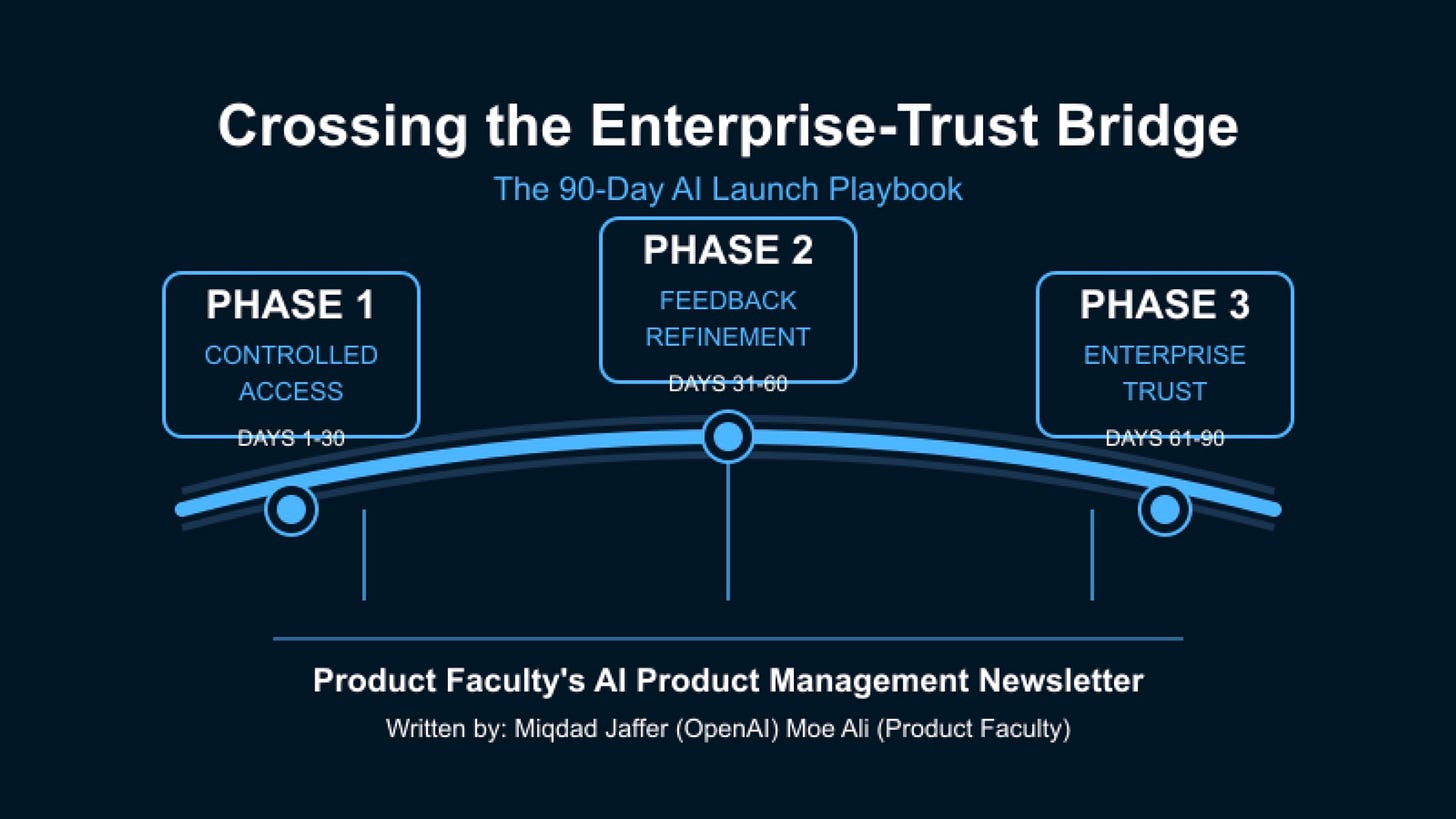Crossing the AI Enterprise-Trust Bridge
How Notion and HubSpot Mastered the 90-Day AI Launch: A Playbook for Product Leaders
Want to hear a podcast discussion about this post? Listen here 👇
Over the past 18 months, we've seen a wave of enterprise companies launching AI features. While the headlines focus on the technology, a more interesting pattern has emerged in how successful companies approach these launches. Through analysis of public launches from Notion, Intercom, HubSpot, and others, we can identify crucial strategic decisions that separate successful AI product launches from those that struggle to gain traction.
A quick note before we dive in... If you're looking to build skills for leading AI initiatives, my AI Product Management Certification (rated #1 on Maven) is available with a $500 discount for the first five newsletter readers who use code ED2.
The 90-Day Pattern
A particularly interesting pattern emerges when examining successful enterprise AI launches: the "90-day progression" from announcement to stable product. This isn't coincidental – it reflects a deliberate strategy that balances market expectations, technical reality, and user adoption.
Let's break down how successful companies structure this 90-day journey:
Days 1-30: Controlled Access Phase
Limited release to <5% of user base
Focus on specific use cases rather than general availability
Heavy emphasis on user feedback collection
Rapid iteration on core workflows
HubSpot's AI rollout provides a clear example. They initially released their AI features to just 2% of their customer base, focusing specifically on email composition and social media workflows [Source: HubSpot's Q2 2023 earnings call]. This allowed them to gather focused feedback while controlling the scope of potential issues.
Days 31-60: Expansion Phase
Gradual increase to 15-25% of users
Introduction of additional use cases
Beginning of pricing model testing
Development of user success patterns
Notion's approach during this phase is instructive. They expanded from their initial writing assistance features to include AI-powered databases and workflow tools, but maintained a waitlist system to control growth [Source: Notion's product blog]. This allowed them to test pricing models while gradually scaling their infrastructure.
Days 60-90: Stabilization Phase
Rollout to general availability
Solidification of pricing model
Development of enterprise controls
Establishment of usage patterns
Intercom's progression here is particularly noteworthy. They used this phase to introduce enterprise-specific features like custom model controls and data retention policies, addressing the concerns that emerged during the controlled phases [Source: Intercom's engineering blog].
The Three Critical Decisions
Through analysis of these launches, three critical decisions emerge that product leaders must get right:
1. Entry Point Selection
Successful launches consistently show a pattern of choosing highly specific entry points rather than broad capabilities. The key questions that shaped successful entry point decisions:
Where do users already have established workflows?
Which tasks have clear success metrics?
Where can AI provide immediate, visible value?
Notion's choice to focus initially on writing assistance rather than their potentially more innovative AI database features reflects this pattern. The writing use case had clear success metrics (time saved, content produced) and built on existing user behaviors.
2. Feedback Loop Design
The most successful launches build in sophisticated feedback mechanisms from day one. This goes beyond simple user feedback to include:
Usage pattern analysis
Success metric tracking
User journey mapping
Feature adoption sequencing
HubSpot's approach here was particularly sophisticated. They implemented what they called "success tracking" – monitoring not just whether features were used, but whether they led to improved outcomes in their customers' marketing efforts [Source: HubSpot product documentation].
3. Value Capture Strategy
The pattern among successful launches shows a clear progression in how they capture value:
Early Phase:
Include AI features in existing plans
Focus on adoption over monetization
Gather usage pattern data
Middle Phase:
Introduction of usage limits
Premium feature identification
Value metric refinement
Late Phase:
Structured pricing tiers
Enterprise-specific offerings
Custom solutions for high-value cases
Key Success Patterns
Analysis of successful launches reveals several consistent patterns:
1. The Workflow-First Approach Successful products integrate AI into existing workflows rather than creating new ones. This seems obvious, but many failed launches attempted to create entirely new user behaviors.
2. The Expectation-Reality Balance Leading companies are remarkably consistent in how they manage the gap between AI capabilities and user expectations:
Clear communication about limitations
Focus on specific, achievable outcomes
Regular updates on improvement areas
3. The Enterprise Trust Bridge Successful enterprise AI products build trust through a consistent pattern:
Start with non-critical workflows
Gradually expand to more crucial processes
Build in clear control and oversight mechanisms
Implications for Product Leaders
These patterns suggest several key considerations for product leaders planning AI launches:
Timeline Planning
Plan for a minimum 90-day progressive rollout
Build in feedback collection mechanisms from day one
Create clear phase progression criteria
Resource Allocation
Heavy emphasis on user research and feedback processing
Significant investment in user education and success
Focus on workflow integration over feature development
Success Metrics
Define clear success metrics for each phase
Build in usage pattern analysis
Create feedback loops for continuous improvement
Looking Ahead
The next wave of AI product launches will likely face even higher user expectations and more sophisticated competition. Product leaders should focus on sustainable value creation, scalability, and clear paths to enterprise value. Product leaders should:
Focus on sustainable value creation over quick wins
Build in scalability from day one
Create clear paths to enterprise value
Why Learning AI Now Matters
Given the increasing importance of AI in product management, now is the critical time to acquire these skills. As we move forward, every product decision will be an AI decision, positioning those with AI knowledge at the forefront of innovation.
For readers who want to prepare for this AI-driven future, I'm offering a $500 discount on my AI Product Management Certification course to the first 5 people who use code ED2.




